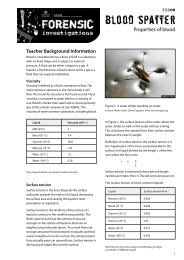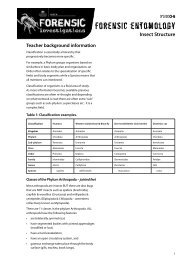FSE 10 Teachers activity [PDF File, 3.0 MB] - Centre for Learning ...
FSE 10 Teachers activity [PDF File, 3.0 MB] - Centre for Learning ...
FSE 10 Teachers activity [PDF File, 3.0 MB] - Centre for Learning ...
Create successful ePaper yourself
Turn your PDF publications into a flip-book with our unique Google optimized e-Paper software.
<strong>FSE</strong><strong>10</strong><strong>for</strong>ensic entomology<strong>Teachers</strong>: Activity In<strong>for</strong>mationANSWERS TO STUDENT QUESTIONS1. What day in November did Mr X die?3rd (November 2006)2. What is your supporting evidence?Lucilia sericata is a primary strike fly and ovipositswith 4 hours of a person dying. The estimateddate of 3/11/06 is based on calculations of insectdevelopment from pupae found on the body.Chrysomya rufifacies is a secondary strike flyand will oviposit with 4 days of a person dying.Estimated date of the eggs being laid is 7thNovember. Taken together the calculationssupport the date of the murder to be 3 November.3. Lucilia sericata was NOT one of the speciesthat was net caught over the corpse on the11 th November? Yet, collected pupa weresubsequently found to be Lucilia sericata.Chrysomya rufifacies were net caught at thecrime site AND were identified as the larvaethat were found on the corpse. How do youaccount <strong>for</strong> this?Mr X’s body was found in a country locale – noturban – however Lucilia sericata pupae were foundon the body. Lucilia sericata is usually found inurban habitats. This suggests that the corpse wasmoved from an urban to a rural setting severalhours after the murder.4. How accurate do you think yourcalculations are?Fair5. What are the limitations of this method <strong>for</strong>estimating PMI?There are several limitations:• only 2 species of flies are used in the calculations• there are no correction factors <strong>for</strong> shadeand or dampness affecting the rate of insectdevelopment• shade is known to affect faunal succession –some flies prefer shaded areas• the actual temperature at the suspected locationis not known• the faunal succession pattern of insects maynot be specifically known <strong>for</strong> the geographiclocation• the internal temperature of the corpse was notmeasured. This could affect the calculations <strong>for</strong>the rate of insect development.6. What extra data would you need to provide amore accurate and precise PMI?Accurate PMI calculations depend on knowing3 main things: the order of and time length <strong>for</strong>specific species of fly to reach the body and therate of development of each species.The order and time length and the rate ofdevelopment of specific species dependson variables such as the particular season,geographic location, position of body in termsof indoors/outdoors and above or below the soil,urban or rural areas and being in full sun or theshade (to name a few).7. Two species of blow fly were involved indetermining PMI <strong>for</strong> the crime: Lucilia sericataand Chrysomya rufifacies. Why would the<strong>for</strong>ensic entomologist calculate in<strong>for</strong>mation<strong>for</strong> both species of fly rather than just one typeof fly?Calculating in<strong>for</strong>mation <strong>for</strong> 2 species of fly thatare known to behave within different timeframes(primary and secondary strike flies) provides a<strong>for</strong>m of triangulation of data. If both calculationsindependently support the proposed datethe <strong>for</strong>ensic entomologist would have greaterconfidence in the calculations.8. Dr Dadour noted that the corpse was foundin a damp and shady location. Wouldthis in<strong>for</strong>mation have any bearing on hiscalculations <strong>for</strong> PMI?Potentially this in<strong>for</strong>mation would affecthis calculations. For an insect to developthe temperature must remain between aminimum and maximum value. The shaded areatemperature would be lower than out in thefull sun. Dampness of the soil/area would alsopotentially affect the rate of development.23


![FSE 10 Teachers activity [PDF File, 3.0 MB] - Centre for Learning ...](https://img.yumpu.com/45506425/23/500x640/fse-10-teachers-activity-pdf-file-30-mb-centre-for-learning-.jpg)
![FSP 19 Anthropometry [PDF File, 298.3 KB]](https://img.yumpu.com/51210323/1/184x260/fsp-19-anthropometry-pdf-file-2983-kb.jpg?quality=85)


![FSE 09 Case studies [PDF File, 140.2 KB] - Centre for Learning ...](https://img.yumpu.com/48750159/1/184x260/fse-09-case-studies-pdf-file-1402-kb-centre-for-learning-.jpg?quality=85)
![FSE 03 [PDF File, 125.2 KB] - The University of Western Australia](https://img.yumpu.com/47991868/1/184x260/fse-03-pdf-file-1252-kb-the-university-of-western-australia.jpg?quality=85)
![FSE 01 Overview [PDF File, 163.0 KB]](https://img.yumpu.com/47583056/1/184x260/fse-01-overview-pdf-file-1630-kb.jpg?quality=85)

![Chapter 03 [PDF File, 468.5 KB] - Centre for Learning Technology](https://img.yumpu.com/44881443/1/184x260/chapter-03-pdf-file-4685-kb-centre-for-learning-technology.jpg?quality=85)
![Chapter 09 5 [PDF File, 192.4 KB]](https://img.yumpu.com/44599682/1/184x260/chapter-09-5-pdf-file-1924-kb.jpg?quality=85)
![FSB 03 [PDF File, 151.9 KB]](https://img.yumpu.com/43260078/1/184x260/fsb-03-pdf-file-1519-kb.jpg?quality=85)

![FSE 11 Rearing flies [PDF File, 388.4 KB]](https://img.yumpu.com/41885287/1/184x260/fse-11-rearing-flies-pdf-file-3884-kb.jpg?quality=85)
![FSP 26 Crime Dossier [PDF File, 3.2 MB]](https://img.yumpu.com/36466452/1/184x260/fsp-26-crime-dossier-pdf-file-32-mb.jpg?quality=85)
![FSE 07 Forensic entomology [PDF File, 196.9 KB]](https://img.yumpu.com/35416705/1/184x260/fse-07-forensic-entomology-pdf-file-1969-kb.jpg?quality=85)